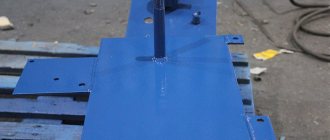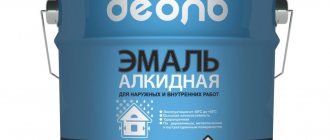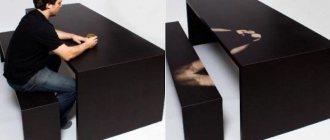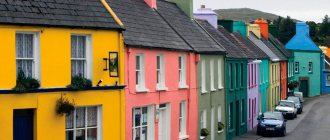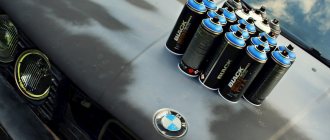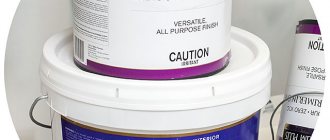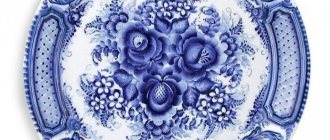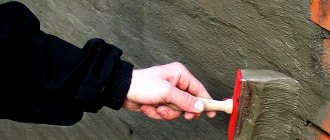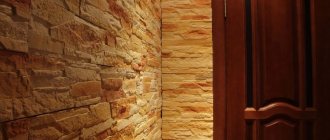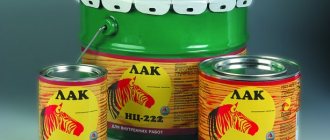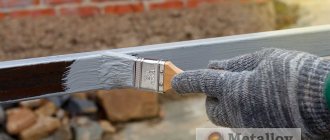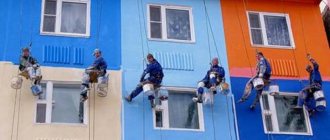Alkyd paint - what is it?
Alkyd enamel means a universal composition based on organic solvents, such as purified kerosene. The mixture also contains alkyd varnish, a number of fillers (sand mixture, oil, marble or granite chips, etc.), solvents (turpentine or white spirit) and color pigments.
The composition of the material is determined by the areas of its use. Products for wood processing are enriched with antiseptic additives, and for metal products - with components that protect against corrosion.
Advantages and disadvantages
Alkyd paints are popular due to several advantages. Among them:
- Ease of distribution. Like traditional paint, alkyd enamel is quite easy to apply. The main thing is to adhere to the manufacturer’s recommendations indicated on the packaging and follow personal safety rules.
- Wide range of applications. On sale there are series of enamels for exterior and interior work, painting windows and doors, furniture products, heating radiators and other interior items. It is allowed to combine different shades to realize original ideas.
- Anti-corrosion characteristics. Alkyd compounds prevent corrosion on metal products.
- Fast polymerization. The paint dries within 24 hours. Moreover, after an hour it ceases to be sticky, which allows you to continue repairs indoors.
- Low cost. Compared to many other types of paints and varnishes, alkyd enamel is much cheaper. In conditions of economic instability, this is an important factor.
However, the product also has negative sides. The key disadvantage is considered to be low temperature resistance. Use of the paint is permitted in conditions with temperatures of +5…+30°C.
There is an opinion that alkyd paints and varnishes emit a strong unpleasant aroma. But this is partial truth, because... Manufacturers of modern paint series refuse to use toxic substances with an intense odor. At the same time, the composition remains chemical components that are dangerous to human health.
Advantages and disadvantages
The alkyd composition has the following advantages:
- reasonable cost;
- a wide palette of shades and colors (if white enamel is used for external application, it may turn slightly yellow over time);
- water-repellent properties;
- high resistance to mechanical damage;
- Possibility of use for interior or exterior work;
- washes well with household products, so such alkyd compositions can be used to decorate walls in rooms with high humidity;
- relatively short drying period;
- color stability even after the layer has hardened;
- good hiding power, fluidity;
- versatility;
- crack resistance;
- good adhesive properties;
- Glossy or matte alkyd composition prevents corrosion on the metal substrate.
This paint is easy to use. No drips appear during its application. But this paint has disadvantages:
- unpleasant pungent odor, which requires the use of special products during operation;
- tendency to change shade;
- low vapor permeability;
- fire danger.
During operation, the paint releases toxic substances, but after the layer dries it becomes safe.
Composition of alkyd paints
Polyester resins are common in the paint and varnish industry. In addition, the following additives are used for the production of alkyd coatings:
- Film formers.
- Diluents and solvents.
- Pigments.
- Fillers.
- Hardeners.
- Excipients.
Film formers
The key component of enamel is the film former. The following types of additives are found in alkyd mixtures:
- Pentaphthalic.
- Glypthal.
- Ethrifthalic.
- Xyphthalic.
Releases with pentaphthalic elements create a thick film with good resistance to mechanical stress. Hypthal foams dry quickly, but do not provide protection from precipitation and other influences. Therefore, their main area of application is interior work.
Pigments
To ensure that the finishing layer has a characteristic shade and opacity, special pigments are added to the paintwork composition. They are insoluble fine powders. Depending on the source material, pigments can be natural or inorganic.
They affect the color saturation and durability of the paintwork. In addition to decorative qualities, the components also determine the performance characteristics of the alkyd composition.
Some additives create a protective film, preventing moisture penetration and rust.
Fillers
Needed to improve the technological properties of paints and varnishes. They affect hiding power, opacity, viscosity and wear resistance.
Carbonates, barites and silicates are used as fillers. Granite and quartz make the mixture resistant to wear, and mica protects the surface from high temperature and electrification.
To increase the degree of particle dispersion, manufacturers add analogues of organic fillers to the composition.
Carbonates are used as paint fillers to improve viscosity and wear resistance.
Supplements
Some components are needed to speed up the drying process, others - to increase the resistance of the coating to negative factors and maintain the plasticity of the paint. Anticoagulants and stabilizers promote uniform distribution of the composition over the surface without separation.
Solvents and thinners
Solvents are selected taking into account the fat content of alkyds. When the indicator is high, aliphatic components are used, when the indicator is medium, a mixture of solvents is used, and when the indicator is low, aromatic high-boiling additives are used. Thinners are needed to change the flow properties of paints and varnishes.
Matte options
In addition to glossy products, matte alkyd paints are also available on the market. They are used for indoor and outdoor work.
The matte surface looks impressive; among other characteristics, it is resistant to mechanical stress and is not afraid of moisture, oil and aggressive cleaning agents. There are variants of compositions operating in the range from -50°C to +60°C.
Areas of application
Alkyd enamels not only prevent the negative effects of external factors on the treated surface, but also protect the product from corrosion. The range of applications for such mixtures is quite extensive. Today they are used for:
- Treatment of metal roofing, drainage communications, fencing, heating radiators and benches.
- Painting wooden structures: log walls, facade parts of frame structures, etc.
- Decoration of concrete slabs, asbestos-cement screed and brickwork.
To form a protective film on a concrete or wooden surface, it is recommended to purchase an alkyd composition with urethane fillers.
Recommendations for coloring
To create a uniform, smooth layer, it is necessary to bring the surface to an ideal state. This is done by leveling with plaster or putty mixtures.
Of course, alkyd paints can easily mask microcracks and small defects, but serious damage, on the contrary, will be emphasized, thereby significantly spoiling the aesthetics of the decorative surface.
The surface should be treated with a primer liquid so that the applied layer of paint “adheses” perfectly to the base.
You can start painting. The application of suspensions is carried out using traditional construction devices in the form of rollers, brushes or a spray gun.
Properly selected types of alkyd paint are not only a way to decorate the surface, but also a guarantee of the health of others. That is why it is better to refuse to buy emulsions of dubious production and pay a little more, but at the same time benefit from the quality of the composition.
Classification of alkyd paints
Paints and varnishes based on alkyd particles differ in properties. There are mixtures on sale with a wide range of uses and specialized releases for strictly designated purposes.
Some paint packages contain markings GF-230, PF-115, etc. They are necessary for easier orientation in the types of paints.
Enamel
They are produced on a varnish basis and are distinguished by their versatility. They can be used to paint almost any type of surface, including asbestos-cement slabs, brickwork, wood, metal, etc.
There are the following types of enamels on the market:
- Glypthal. They quickly harden and acquire the declared properties. Suspension GF-230 is quite in demand. Enamel is used as interior paint, because... subject to wear and destruction due to negative external influences.
- Pentaphthalic. A common type of enamels with moisture protection and abrasion resistance. It is quite difficult to wash off or erase such a coating.
The advantage of enamel suspensions is their increased water resistance.
Alkyd enamel paint.
Oily
Drying oil is used as the main component. Depending on the degree of consistency, there are:
- Liquid.
- Pasty.
In addition, they are classified taking into account the nature of the gloss:
- Matte.
- Semi-matte.
- Glossy.
Oil suspensions are popular due to the ability to choose the optimal gloss intensity. Matte subtypes mask minor defects and are suitable for cladding decorative items in the living room.
Semi-matte series create a protective film from moisture, so they can be used in buildings with high humidity.
Glossy paints are needed for decorative purposes. With their help, you can emphasize any element in the interior or divide the room into zones.
Properties of alkyd materials
All positive characteristics are related to the composition of the varnish or enamel. It is important to consider the internal properties of paints and varnishes. If these are dried alkyds that have a low or high drying temperature, then they can be used as an independent substance to create a film on the surface when creating varnishes and paints. We are talking about a lot of different resins. If these are non-drying alkyds, then they are used only together with urea. They also use cellulose nitrates, which increase the possibility of bonding between the metal and the coating.
Whatever the fatty characteristics of the resinous substance, the same will be viscous, ease of application of paint or varnish. Fatty property and compatibility of the material with oily material. Associated with it is the process of drying, hardening, the appearance of shiny particles, standing, and the work of the components of the material, which can be very different. We are talking about resistance to natural phenomena and other characteristics of the paint and varnish material.
If the fat content of alkyds is less than fifty percent, then it will easily dissolve in hydrocarbon, ketone mass, and essential alcohol.
When there is more fat, the liquid becomes more viscous, and the substance dissolves easily in alcohol. Excellent company with different fatty substances. Pigments easily enter and mix with paints. This makes it more elastic and resistant to weather conditions. True, the fatty resins included in paints and varnishes have low drying properties and hardness, so the paint or varnish can be easily smeared if not enough time has passed.
Varnish or paint that dries best is made using alkyds, which are modified substances of fatty particles, in particular flax, or their compatibility with tung oil. Although the addition of these fats reduces hardness and stability, it slows down the progression towards wear.
It is better to choose pentaphthalic paint materials, since glyphthalic ones, which are usually thicker, do not over-harden when cold dried, which means that the surface that was covered with them does not crack. But they dry quickly and are also more resistant to water.
Thanks to modified alkyd paints and varnishes, it is possible to obtain surfaces that are decorative and protected from environmental influences. Alkyds contribute to the fact that the enamel acquires an increased hardening property. They are used both inside and outside. Moreover, the operating time is quite long.
Color palette of alkyd paints
The shade palette of alkyd paints and varnishes is not wide enough. But it can be diversified by tinting. To do this, you should buy a suitable dye and combine it with the main color. You can also try mixing several dyes to get an unusual shade.
Each type of enamel has a color range. Thus, the PF-223 series includes 17 tones, and the GF-230 includes shades such as milk, coffee, chocolate, etc. Aerosol paints in cans also have a wide selection.
Black, brown and white colors are suitable for interior work.
Differences between paint and enamel
A composition based on filler, color pigment, solvent and binding additives is called paint. The desired shades are obtained by mixing the pigmenting components. The protective film is created by polymer particles. Other inclusions are necessary to create haze, fire and moisture resistance and other technological properties.
The pigment, which consists of resin or varnish, is called enamel. Such paints and varnishes contain organic solvents, fillers and additives of natural origin. The required shade is created using red lead, soot, titanium dioxide and ocher. The thickness of the consistency is regulated using construction solvents, such as turpentines, solvents and white spirits.
Paint selection criteria
When going to the store to buy paint, you need to be able to decipher different markings and symbols. This will allow you to narrow the selection segment to the required quantity and eliminate series that are incompatible with the type of surface.
An important criterion is the material of the coating that will be painted. Specialized compounds have been developed for metal, wood, plaster and stone. Next, it’s worth calculating the surface area in square meters in order to plan the average consumption of the substance.
Numerical and alphabetic designations
The GF and PF markings indicate that the series belongs to the glyphthalic or pentaphthalic group. NC refers to nitrocellulose enamels, which dry quickly and create a pleasant gloss on the surface.
The designation KO indicates the presence of organosilicon polymers in the composition, which counteract atmospheric and temperature influences. CS are chemically resistant suspensions designed to protect metal substrates.
The FA marking is found in the description of oil-phenolic enamels.
Also in the classification of alkyd enamels there are digital designations:
- Enamels for external painting works.
- Compositions for internal use.
- Preservation materials that are used as temporary covering.
- Hydrophobic models.
- Releases to repel pests.
- Oil and petrol resistant.
- Chemically resistant.
- Heat resistant.
- Electrical insulating.
Features of using alkyd paint
Alkyd coatings are easy to apply and do not require special painting skills. Before spreading the paint, you need to prepare the surface and wash off the previous coating, traces of dirt and grease. It may be necessary to apply a coat of primer and remove the old cladding. Painting is done using a brush, roller or spray gun. In addition, necessary supplies include solvent, masking tape, and personal protective equipment (gloves and a respirator).
Dilution of the composition
It is necessary to dilute the paint to reduce the viscosity of the composition. A good solvent is white spirit, which is present in the production of the working mixture and guarantees the absence of dangerous chemical reactions.
The use of cans simplifies the application process, because... The paint is already presented in the optimal consistency and is suitable for application.
A good solvent for thinning paint is white spirit.
Enamel consumption
The optimal consumption of alkyd enamel is 150 g/sq.m. m. 1 liter of mixture is enough to paint approximately 10 square meters. m of surface. The exact consumption is determined by the consistency and type of solvent. In addition, the indicators also depend on the specifics of the surface being painted. Thus, metal products require less mixture than concrete or wood.
Features of practical application
Alkyd paints are effective to use and do not require special painting skills. Before application, it is necessary to clean the surface from the previous coating, wash it of dirt and treat it with a degreasing compound. For painting you will need:
- brush, roller or spray gun;
- solvent;
- masking tape;
- respiratory mask and gloves.
The composition is diluted to reduce the viscosity of the composition. White spirit is optimal as a solvent. It is used in the mixing process, which guarantees the absence of negative chemical reactions. Using aerosol cans greatly simplifies the process - the paint in them is already in the optimal consistency and is ready for application.
In order to obtain a durable and strong coating, alkyd enamel is applied in several layers.
If painting work takes place indoors, it will be necessary to provide high-quality exhaust and ventilation - this is due to the toxicity of the components contained in the composition. Also, it is necessary to work with gloves and a respirator mask.
Enamel consumption
The average coating rate for alkyd enamels is 150 g/m2. As a rule, one liter should be enough to treat ten square meters of surface. It all depends on the consistency of the enamel, as well as the solvent used for dilution and the characteristics of the surface. Painting metal structures will be more economical than treating similar surfaces made of wood or concrete.
Before painting, it is strongly recommended to calculate the amount of work to be done in advance in order to purchase the optimal amount of enamel.
Popular manufacturers
The following companies enjoy a good reputation and positive customer reviews:
- Kudo. It produces high-quality products that are used for painting car body parts, tiles, wood and metal products. The mixture is used both for outdoor work and for decorating walls indoors. It can be purchased in cans for universal use. All series available in the catalog provide a high degree of adhesion, durability and weather resistance of the coating.
- Olimp. Produces various alkyd and alkyd-urethane coatings. The range includes mixtures for cladding windows, doors, concrete screeds, heating devices and facade parts of buildings. The compositions contain anti-corrosion and antiseptic additives.
Manufacturers
The quality of any paint and varnish material depends on the manufacturing company.
The leading positions in the Russian market of paints and varnishes are occupied by the following productions:
- Lakra (Russia);
- Tex (Finland/Russia);
- Tikkurila (Finland).
Alkyd coatings from these manufacturers have proven themselves well and are in demand not only among amateurs, but also among professionals.
Lakra
A company called Lakra has been producing and selling various coatings since 1996. Alkyd coatings of this brand are universal in their composition. Based on their areas of application, they can be divided into several categories:
- for application to the floor;
- anti-corrosion coatings;
- for painting pipes and batteries.
Only the highest quality materials are used for the production of paint and varnish coatings. Paints are made from imported raw materials using the latest technologies.
The materials produced by Lakra are resistant to external factors such as water, sun and wind. After the coating dries, it does not emit any toxic fumes and becomes completely safe for humans.
Tex
This Russian-Finnish production rightfully occupies one of the leading positions in the finishing materials market. Its products are fully adapted to Russian climatic conditions. Paints are produced according to the quality standards of the Tikkurila concern. Products can be divided into several types:
- universal: can be used on most surfaces. Perfectly suitable for interior and exterior finishing work. The period during which it retains its properties is five years;
- intended directly for application to wooden or fiberboard floors, the composition is resistant to external mechanical influences and is not destroyed by household chemicals;
- alkyd-urethane mixture for covering concrete floors.
Rating of the best alkyd paints
The list contains the best paint releases based on customer reviews. They are compatible with most surfaces and ensure the base is resistant to negative influences.
Dulux Master
It has increased adhesion and can be applied both mechanically and manually. Layering is done after the previous layer has completely dried, which takes about 12 hours at a temperature of +23°C and humidity up to 50%.
1 liter of mixture is enough to treat 12 square meters. m area.
Dulux Master can be applied either mechanically or manually.
Tikkurila Valtti Arctic
The Finnish product is produced on the basis of natural oils and is diluted with a special liquid. It is used for all types of surfaces, including different types of wood, concrete and metal. Customer reviews mention the ability to treat previously painted items. Consumption per 12 sq. m is 1 l. The drying process takes 2-3 hours.
Capadur UniversalLasur
The series is produced in Germany on the basis of welded resins and solvent. The mixture is odorless, which is why it is used for interior decoration.
Available in 750 ml, 2.5 l and 5 l packaging. At a temperature of +20°C and a humidity of 60%, drying lasts 12 hours.
Tikkurila Empire
The substance is distinguished by its ease of dilution with a solvent. In addition, the composition contains thickeners that affect the elasticity and viscosity of the consistency. These features make the series popular for interior designers.
Pros and cons of alkyd compounds
Their undoubted advantage is increased strength and durability. The film formed during the drying process of paint has great elasticity, so it cracks less than oil film.
The ability to withstand even severe temperature changes allows the use of alkyd enamels for outdoor use. They are not afraid of sunlight, so they do not turn yellow and fade more slowly in the sun. The chemical resistance of such compositions is also excellent - they can be washed even with fairly aggressive detergents.
Significant advantages of enamels are minimal consumption and high drying speed. If oil paints take 2 days to harden, alkyd enamel dries faster - no more than 24 hours. When introducing special hardeners, this requires even less time - up to 6 hours. Its service life is 15 years, and when used outdoors 6 years.
But enamels have a significant drawback - until they dry and form a film, they emit a pungent odor. Therefore, you should work with them in ventilated areas wearing a respirator. The hardened film no longer poses a health hazard - the toxic substances erode from it.
